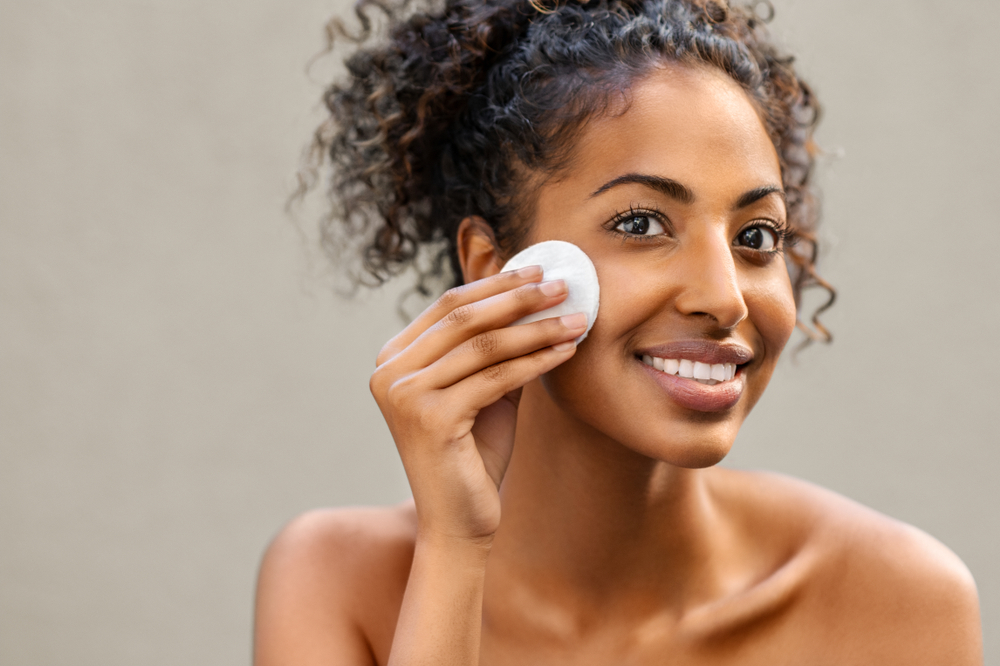Your nightly makeup removal ritual might be doing more than just cleaning your face—it could be systematically disrupting your hormonal balance in ways that affect everything from your menstrual cycle to your fertility. The same ingredients that effectively dissolve waterproof mascara and long-wear foundation are also dissolving your body’s natural hormone production and regulation systems.
The beauty industry has filled makeup removers with synthetic chemicals that can penetrate your skin and interfere with endocrine function, but these hormone-disrupting effects are rarely discussed in product marketing or safety information. What should be a simple cleansing step has become a daily exposure to compounds that can alter your reproductive health, metabolism, and overall hormonal wellness.
The cumulative effect of using hormone-disrupting makeup removers daily for years can create subtle but significant changes in how your body produces, processes, and eliminates hormones. These changes often develop gradually, making it difficult to connect skincare products with hormonal symptoms that seem unrelated to your beauty routine.
Phthalates are infiltrating your endocrine system
Phthalates, commonly used as solvents and fragrance carriers in makeup removers, are among the most pervasive endocrine disruptors in personal care products. These chemicals can mimic estrogen in your body, creating hormonal confusion that affects reproductive health, menstrual regularity, and fertility.
The skin absorption of phthalates from makeup removers allows these chemicals to enter your bloodstream directly, bypassing the liver’s detoxification processes that would normally help eliminate toxins consumed orally. This direct absorption creates higher concentrations of hormone disruptors in your system.
Daily exposure to phthalates through skincare products can accumulate in fatty tissues throughout your body, including breast tissue and reproductive organs. This bioaccumulation means that even small daily doses can build up to significant concentrations over time.
Phthalates interfere with the production and function of multiple hormones including estrogen, testosterone, and thyroid hormones. This broad hormonal disruption can affect mood, energy levels, weight management, and reproductive health in ways that seem unrelated to skincare use.
The timing of phthalate exposure matters particularly for women of reproductive age, as these chemicals can interfere with ovulation, implantation, and early pregnancy development. The daily use of phthalate-containing products creates chronic exposure during critical reproductive periods.
Parabens are playing havoc with your estrogen
Parabens used as preservatives in makeup removers have weak estrogenic activity that can disrupt normal estrogen signaling pathways. While individual exposures might seem insignificant, the cumulative effect of daily paraben exposure can alter estrogen-dependent processes throughout your body.
The estrogenic effects of parabens can contribute to estrogen dominance patterns that affect menstrual cycles, PMS symptoms, and reproductive health. This artificial estrogen activity can overwhelm your body’s natural hormone balance and interfere with normal cyclical hormone fluctuations.
Paraben exposure has been linked to changes in breast tissue development and may contribute to increased risk of hormone-dependent health conditions. The bioaccumulation of parabens in breast tissue creates particular concerns about long-term health effects from cosmetic use.
The combination of multiple paraben types commonly used in skincare products can create synergistic effects where the total hormonal impact exceeds what would be expected from individual compounds. This cocktail effect makes it difficult to assess the true safety of paraben-containing products.
Methylparaben and propylparaben, the most common forms used in makeup removers, have different absorption rates and tissue distributions, creating complex exposure patterns that affect multiple body systems simultaneously.
Synthetic fragrances hide hormone-disrupting cocktails
The generic term “fragrance” on makeup remover labels can hide dozens of undisclosed chemicals, many of which have hormone-disrupting properties. This regulatory loophole allows companies to include endocrine disruptors without specifically listing them on ingredient labels.
Synthetic musk compounds used in fragrances can interfere with hormone metabolism and have been found to accumulate in human fat tissue and breast milk. These persistent chemicals can affect hormonal function long after the products containing them have been discontinued.
Benzyl salicylate and other fragrance components commonly found in makeup removers can act as endocrine disruptors while also causing skin sensitization that triggers inflammatory responses. This inflammation can further disrupt hormonal balance through stress hormone activation.
The volatile nature of many fragrance compounds means they’re readily absorbed through both skin contact and inhalation during use. This dual exposure pathway increases the total dose of hormone-disrupting chemicals entering your system.
Fragrance-related hormone disruption often affects multiple systems simultaneously, including reproductive hormones, stress hormones, and thyroid function. This multi-system impact can create complex symptom patterns that are difficult to trace back to cosmetic use.
Surfactants are compromising your skin barrier
Harsh surfactants used to dissolve makeup can damage your skin barrier, increasing the absorption of other potentially harmful ingredients in the product. When your skin barrier is compromised, it becomes more permeable to chemicals that might otherwise be excluded.
Sodium lauryl sulfate and similar detergents can create microscopic damage to skin cells that allows hormone-disrupting chemicals to penetrate deeper into tissues. This increased penetration amplifies the systemic effects of endocrine disruptors in makeup removers.
The inflammatory response triggered by harsh surfactants can activate stress hormone pathways and disrupt normal hormonal balance. Chronic low-level skin inflammation from daily makeup remover use can contribute to systemic hormonal dysfunction.
Skin barrier damage from aggressive cleansing agents makes your skin more vulnerable to environmental toxins and allergens that can further disrupt hormonal function. This creates a cascading effect where cosmetic use increases vulnerability to other hormone-disrupting exposures.
The cumulative skin barrier damage from daily use of harsh makeup removers can lead to increased absorption of hormone disruptors from all skincare and cosmetic products, amplifying the total toxic burden on your endocrine system.
Your liver is overwhelmed by cosmetic toxins
The liver’s role in processing and eliminating hormones becomes compromised when it’s constantly working to detoxify synthetic chemicals from cosmetic products. This detoxification burden can interfere with normal hormone metabolism and clearance.
Phase I and Phase II liver detoxification pathways that process both natural hormones and synthetic chemicals can become saturated with cosmetic toxins, leading to incomplete hormone metabolism and accumulation of harmful hormone metabolites.
The competition between cosmetic chemical detoxification and natural hormone processing can result in inefficient clearance of both synthetic toxins and natural hormones, creating imbalances that affect multiple body systems.
Makeup remover chemicals that require extensive liver processing can deplete the nutrients and cofactors needed for healthy hormone metabolism, creating deficiencies that further impair endocrine function.
Chronic liver burden from cosmetic chemical exposure can contribute to estrogen dominance patterns as the liver becomes less efficient at clearing excess estrogen from the body, leading to hormonal imbalances that affect reproductive and metabolic health.
Safer alternatives that actually work
Oil cleansing with simple, single-ingredient oils like jojoba, argan, or sunflower oil can effectively remove makeup without exposing your skin to hormone-disrupting chemicals. These natural oils work through similar mechanisms as synthetic makeup removers but without the endocrine risks.
Micellar waters made with minimal, clean ingredients can provide gentle makeup removal without harsh surfactants or hormone-disrupting preservatives. Look for products with short, recognizable ingredient lists and avoid those with synthetic fragrances.
DIY makeup removers using ingredients like coconut oil, witch hazel, or castile soap allow complete control over what touches your skin while providing effective cleansing. These homemade alternatives eliminate exposure to synthetic preservatives and fragrances.
Balm cleansers with organic, food-grade ingredients can dissolve makeup effectively while nourishing skin rather than disrupting its barrier function. These products often work better than harsh chemical removers while supporting rather than compromising skin health.
Double cleansing with gentle, hormone-safe products provides thorough makeup removal without chemical exposure. This method uses an oil-based cleanser followed by a gentle water-based cleanser to ensure complete removal without harsh ingredients.
Reading ingredient labels carefully and avoiding products with phthalates, parabens, synthetic fragrances, and harsh sulfates helps minimize hormone-disrupting exposures from makeup removal routines. This ingredient awareness is essential for protecting endocrine health.
Supporting your body’s natural detoxification processes through proper nutrition, hydration, and liver support can help your system better handle unavoidable chemical exposures while maintaining hormonal balance.
The goal isn’t to eliminate all skincare products but to choose options that support rather than undermine your hormonal health. Making informed choices about makeup removers can significantly reduce your daily exposure to endocrine disruptors while maintaining effective cleansing routines.
Understanding that hormonal health affects every aspect of wellbeing—from mood and energy to fertility and metabolism—helps prioritize the selection of hormone-safe personal care products as an essential component of overall health maintenance.


















